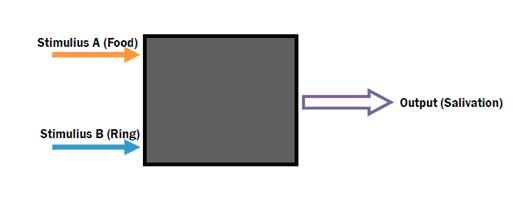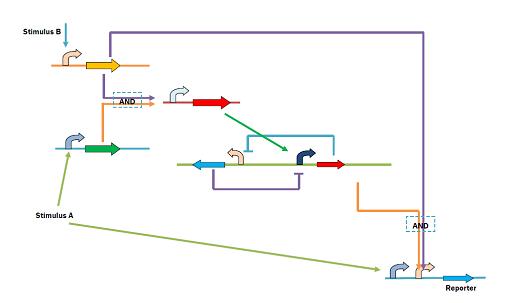Team:PKU Beijing/Project
From 2009.igem.org
| Line 22: | Line 22: | ||
<tr> | <tr> | ||
<td width="16"></td> | <td width="16"></td> | ||
| - | <td width="833"></html> | + | <td width="833"></html> |
| + | A school bell rings and you suddenly feel anxious, nervous - you begin to sweat, fret. Though it's been years since that school bell commanded you, it still brings the same stress, reminding you of the dreaded math test next period. Though the school bell should not be connected to anxiety, your brain has connected the two, thus exhibiting '''classical conditioning'''. Although our E. coli do not fear school bells, they are now equipped with a system similar to such, exhibiting both '''learning''' and '''memory'''. | ||
| - | + | Ivan Pavlov conducts his experiment with food and a bell (as well as other arbitrary stimuli but for conciseness, only the bell will be mentioned). Naturally, the bell causes no such salivation. However, after a training session in which both the food and ringing is simultaneously shown and heard, the dog builds a relationship between the bell and food. Thus, simply the ringing alone can cause salivation; Pavlov called this the “conditioned reflex.” Not only did Pavlov earn the 1904 Nobel Prize in Physiology and Medicine for this work, but was, and still is a milestone for the research of learning and cognition. | |
| - | + | Elaborating upon the mechanism of the Conditioned Reflex (the correlation between two objects being memorized by the brain), is thought to be the result of two neurons simultaneously working together. As the famous Hebbian Rule states, “Firing together, wiring together.” This theory is the basis of the “Artificial Neural Network,” which modifies the connectivity of two nodes in the network according to the concurrence of activity. Connectivity increases if the two nodes are activated or repressed at the same time; otherwise, the connectivity is weakened. Molecular support of the theory was discovered later in the form of “Long Term Potentiation.” | |
| - | + | This year, the PKU iGEM team wants to build an E. coli version of the classical “conditioned reflex experiment.” Pavlov had his dogs, we have our E. cogs. | |
| + | |||
| + | Our memory system is essentially a “black box” – it senses two stimuli, but it’s up to decide how to construct it. | ||
| + | |||
| + | [[Image:PKU_Prelim_1.JPG]] | ||
| + | |||
| + | When the system is at its original state, the presence of stimulus A will lead to an output; stimulus B, however, will lead to no such output. After a few training sessions with both the stimuli A & B, the state of the black box is modified, in which the presence of either stimuli alone can lead to the desired response. Our E. cogs thus have a sequential memory gate quite similar to Pavlov’s dogs. For our circuit, we used inducible promoters as the inputs (stimuli A &B), a toggle switch as the module of memory storage, and combined an AND Gate and OR Gate to connect all such modules. The complete circuit is illustrated in the image below. | ||
| + | |||
| + | [[Image:PKU_Prelim_2.JPG]] | ||
| + | |||
| + | Our circuit demonstrates a new, higher level organization which mimics nature in itself. Biology naturally is complex and adorned with several bells and whistles; here we tried to mimic neurons and their workings by creating a circuit which exemplifies Hebbian learning – firing together, wiring together. The uses for this circuit are infinite: the first AND gate allows for more precise detection of the environment, the bi-stable switch’s memory is stable and quite similar to one of higher eukaryotes and the second AND gate allows for ease of detection whether it be glowing, secreting, or the like. For example, it could sense the presence of chemicals which alone are harmless, but together are quite lethal; this circuit would allow for the detection of both easily. | ||
| + | |||
| + | Memory and learning are two motifs popular in both iGEM and out. From studying such processes, we learn a little bit more about them and about ourselves. Seeing our E. cogs learn and respond is but the first step to many others in the future. As synthetic biology often is, it is not an exact copy, but a model nonetheless. Building upon the groundbreaking work of Pavlov, our E. cogs are yet another milestone on the way to learning and understanding the true complexity of nature. | ||
| + | <html> | ||
</td> | </td> | ||
<td width="16"></td> | <td width="16"></td> | ||
Revision as of 16:41, 30 July 2009


|
|||||||||||
|
|||||||||||
 "
"





